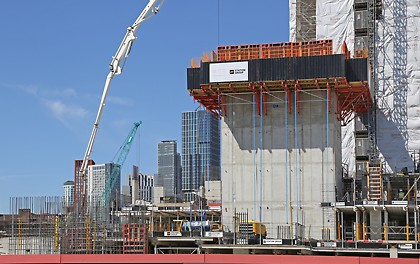
Últimas noticias y notas de prensa PERI
18
feb.

PERI en bauma 2025: Innovaciones para una industria de la construcción preparada para el futuro.
Bajo el lema "Dando forma al futuro juntos", PERI presentará la amplitud de su portafolio y numerosas innovaciones en el área exterior norte (stand FN 718) del 7 al 13 de abril de 2025 en Múnich. En su propio pabellón de exhibición, el fabricante de encofrados y andamios de Weissenhorn, Alemania, ofrecerá a los visitantes no solo exhibiciones impresionantes, sino también demostraciones en vivo y encuentros cara a cara. Además, muchas de las filiales y socios de PERI también presentarán sus productos en la feria bauma de este año.
14
dic.

Escenografía visionaria realizada con 200 toneladas de andamio PERI UP
La Jornada Mundial de la Juventud (JMJ) es un acontecimiento internacional en el que jóvenes de todo el mundo se reúnen cada dos o tres años para encontrarse con el Papa. Fundada por el Papa Juan Pablo II, la JMJ se celebró por primera vez en Roma en 1986 y desde entonces se ha celebrado en numerosas ciudades de todo el mundo. En 2023, el acontecimiento se organizó en Lisboa durante la primera semana de agosto y atrajo a cerca de 1,5 millones de participantes.
23
ago.

¡Barco a la vista! El histórico barco de vapor "Stadt Zürich" se embarca en un mantenimiento seguro
La Zürichsee-Schifffahrtsgesellschaft (ZSG), con más de 100 empleados, ofrece año tras año a cerca de 1,2 millones de pasajeros una experiencia idílica, enmarcada en el panorama de los pintorescos Alpes suizos. Para que la flota de 17 barcos pueda recorrer con fiabilidad 360.000 kilómetros al año por el lago de Zúrich, necesita un mantenimiento regular.
16
ago.

Hito en la construcción del túnel Fehmarnbelt: PERI entrega 10.000t de encofrado especial.
Con una longitud de 18 km, el túnel Fehmarnbelt será el túnel sumergido más largo del mundo y se considera una de las obras de infraestructura más grandes de Europa. PERI desarrolló un concepto de encofrado para la producción centralizada de los elementos estándar del túnel. La solución de ingeniería de PERI se destacó por su rendimiento y productividad, así como por el cumplimiento de los más altos estándares de seguridad. Con el último de un total de doce buques, la entrega del encofrado especial a medida del proveedor de encofrado central para este proyecto se completó en la primavera de 2023 con un volumen de más de 10.000t.
24
may.

La torre residencial más alta de Canadá comienza a levantarse con sistemas de trepado PERI
El proyecto Pinnacle One Yonge es un desarrollo en varias fases, diseñado por Hariri Pontarini Architects. Con su prominente ubicación, frente al puerto de Toronto, las elegantes torres, magistralmente diseñadas, remodelarán el horizonte de la ciudad.
17
mar.

Nueva vida para un hito industrial
Un proyecto de construcción que simboliza la revolución energética. El histórico gasómetro del barrio berlinés de Schöneberg se está transformando en una torre de oficinas de última generación y se convertirá en el nuevo hito del distrito EUREF Campus. Como parte del trabajo de conversión, el edificio protegido será destripado dentro de su marco de acero y reconstruido. Los versátiles sistemas de encofrado y andamios PERI son fundamentales para garantizar que los trabajos de rehabilitación y construcción de la cáscara se lleven a cabo de forma rápida y profesional.
16
mar.
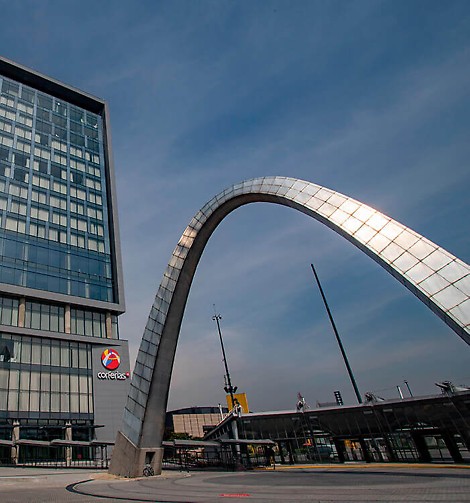
PERI en Expoconstrucción y Expodiseño 2023
Expoconstrucción y Expodiseño es una feria especializada que impulsa el desarrollo y crecimiento de los sectores de la construcción, arquitectura, infraestructura y diseño en la región. Visitenos en la XVII edición de la feria Expoconstrucción y Expodiseño 2023 que se llevará a cabo del 30 de Mayo al 4 de Junio en Corferias Bogotá.
13
ene.

Túnel de acceso al puente sobre el Danubio A26, Linz, Austria
El proyecto A26 es uno de los proyectos de infraestructura más importantes de la ciudad austriaca de Linz y sus alrededores, con el objetivo de aliviar la congestión en su red de transporte urbano. La clave del éxito durante la etapa de ejecución del proyecto fue una solución de ingeniería PERI que fuera innovadora, segura y eficiente en igual medida, junto con un amplio apoyo al proyecto. Lo más destacado: El primer carro de encofrado para túneles totalmente hidráulico con tracción sobre orugas en Austria.
29
nov.

PERI Reflexiona Sobre el Éxito de bauma 2022
Amplias incorporaciones, tecnologías digitales clave y métodos de construcción alternativos están dando forma al futuro de la industria de la construcción.
24
oct.

Lograr el éxito en el comercio de andamios con las innovaciones de PERI
Bajo el lema "Dando forma al futuro", el salón de exposiciones PERI abrirá sus puertas en el recinto al aire libre Norte (stand FN 719) del 24 al 30 de octubre de 2022 en Múnich. Se mostrarán una serie de innovaciones que hacen que la construcción de andamios sea más rápida, segura y económica. Algo que siempre está en el centro de los desarrollos de PERI es el éxito a largo plazo y sostenible del contratista de andamios.
24
oct.
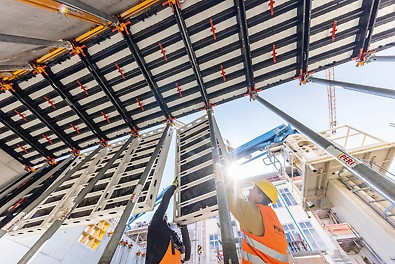
Dando forma al futuro: PERI presenta innovaciones para la industria de la construcción en bauma
Bajo el lema "Shaping the future", el pabellón de exposiciones de PERI abrirá sus puertas en el recinto norte al aire libre (stand FN 719) en bauma 2022 en Múnich del 24 al 30 de octubre de 2022. Con un lavado de cara del probado encofrado de paneles MAXIMO, las innovaciones del sector de encofrado de losas, así como las nuevas tecnologías digitales y disruptivas, como los sensores de construcción PERI InSite, la impresión de construcción 3D y la tecnología MESH, el fabricante de encofrados y andamios está preparando la industria de la construcción para la obra del mañana. Además, los visitantes pueden experimentar de primera mano cómo se promueve el tema de la sostenibilidad en PERI con muchos ejemplos prácticos.
04
oct.

Solución PERI, específica para el proyecto del nuevo rascacielos de Frankfurt.
Con una altura de unos 190 mts, la nueva torre de oficinas y hoteles ONE de CA Immo, de 49 plantas, forma parte del horizonte de la metrópolis de Frankfurt, a orillas del río Meno. El rascacielos llama especialmente la atención por su voladizo triangular en la planta 33, que recuerda visualmente al número "1" y da nombre al edificio.
17
ago.



Construir Puentes con Experiencia en Soluciones y Sistemas Modulares
La planificación y los servicios orientados al cliente, combinados con sistemas modulares coordinados, constituyen la base para desarrollar soluciones de encofrado y andamiaje que se adaptan a casi todos los requisitos de la obra, incluidos los proyectos de infraestructura complejos. Los ingenieros expertos de PERI colaboraron en la construcción del puente Filstal, aportando su amplia experiencia en soluciones.
29
jun.



Subida sincronizada de todas las plataformas: Primer uso del RCS MAX en Corea del Sur
A pocos kilómetros de la capital de Corea del Sur, Seúl, se construyeron dos nuevas torres residenciales de lujo de 140 mt de altura bajo estrictos requisitos de seguridad y en un tiempo de construcción corto. PERI resolvió la demanda de una construcción eficiente así como de bajos costos de personal con el nuevo e innovador sistema de trepado de rieles RCS MAX. Una primicia, ya que el RCS MAX se utilizó aquí por primera vez en suelo surcoreano.
15
abr.
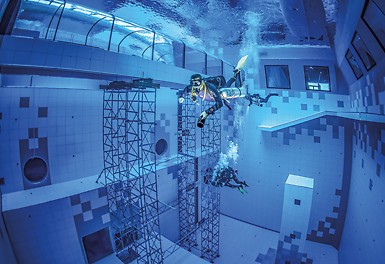
PERI construye la piscina de buceo más profunda del mundo
Lejos de los paraísos de buceo más conocidos del mundo, la ciudad polaca de Mszczonów se ha convertido en el hogar de lo que actualmente es la piscina de buceo más profunda del mundo. Para la construcción de la piscina se utilizaron numerosos sistemas PERI, que tiene una profundidad de hasta 45,50 metros. Lo más destacado fue el desarmado de las torres apiladoras ST 100 utilizadas: por motivos relacionados con los requisitos estáticos, las torres apiladoras solo se pudieron desmontar después de que la piscina se hubiera llenado de agua, no por el personal de la obra de la propia empresa, sino especialmente buzos entrenados.
03
nov.
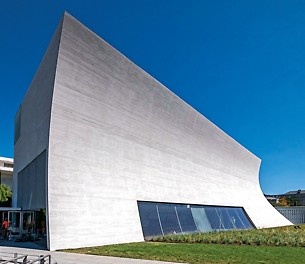
El proyecto PERI Architectural Concrete "The REACH" gana el premio ACI Overall Excellence
La extensión del edificio en el imponente Kennedy Center for the Performing Arts se conoce comúnmente como "The REACH". Consta de tres pabellones interconectados que destacan por su excepcional diseño arquitectónico y hormigón arquitectónico de la más alta calidad. El "proyecto más grande que la vida" ganó el premio a la excelencia general del American Concrete Institute en octubre de 2020 y, por lo tanto, es reconocido como un proyecto que une técnicas particularmente creativas con tecnologías innovadoras. Para este proyecto de construcción especial, PERI desarrolló un concepto de encofrado que combinaba sistemas estándar probados con soluciones específicas del proyecto.
15
oct.
Nuevo Producto: HANDSET Alpha
Llega a Colombia el encofrado manual robusto, económico y fácil de usar.
29
sep.
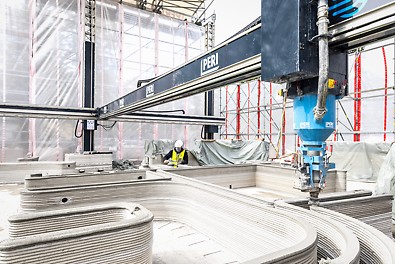
PERI construye el primer edificio residencial impreso en 3D en Alemania
El primer edificio residencial impreso en 3D de Alemania se está construyendo en Westfalia. La nueva técnica de construcción pasa fácilmente por todos los procesos de aprobación regulatoria. La tecnología de impresión de construcción 3D para la construcción residencial ya está lista para el mercado
20
abr.

Reactivación de operaciones
En PERI asumimos el reto de reinventarnos para continuar trabajando por ustedes, nuestro clientes, que son nuestra prioridad número uno.
24
mar.